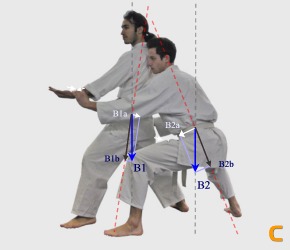



Imagine the attack Katate dori (Picture A). The two involved roles (uke and nage) are away from each other. As the attacker (uke) approaches the defender (nage) at some point they are instantly in a position just as appears in Picture A. The body of both roles has a slight inclinination towards each other which results in the initial contact without the use of any muscle power. Both hands as shown in picture are simply carriers of power coming from center (= center of gravity) of the two bodies. Generally, the contact point remains stationary between the two bodies and this means that the applied forces by the two roles are equal. It is an instantaneous state of balance.
Although it is instantaneous, it is a situation where we can step back and study. Actually to feel the size of the force that we are interchanging, the state of balance and the sense of security offered for both roles by this instantaneous balance. This study allows us to correct our posture, our distance, our centering towards our partner, everything we need to manage keeping the contact without any muscle power, only with the weight of our body.
If the attacker expresses more power than the one of the above equilibrium (just as happens in a real attack) then this will result the body of the defender to move (i.e. move backwards, to make a tenkan, etc). During the movement the defender maintains that kind of contact (with minimal power purely from body weight) and the excess power will be the driving force that will lead the attacker to either immobilization or away from the defender i.e. through a fall.
The defender will use his body to keep the contact, his feet to perform kinesiology and hands to guide the attacker. Will consider the contact point as a fixed point and will move around it. In this way the momentary balance it is not disturbed since no extra power is applied to the opponent.
In fact, as already mentioned, both roles should have the sense of leaning against a fixed point. An object which is leaning on a fixed point will be moved if that point will be moved (based on the laws of nature and physics). Similarly, the uke will follow automatically nage’s kinesiology, maintaining contact without the use of thought, since the bodies are connected center to center.
Trainees will therefore only have to realize which are the contact points. Examples are shown in the pictures below. In the Picture C the feeling of leaning for the nage is the opposite of what is commonly accepted (i.e. that we are always leaning forward). In this case (Ushiro Ryote Dori) the leaning of the nage is backward!


Training based on those concepts is carried out without applying any muscle power. This is not always possible. At the beginning trainees trying to learn the kinesiology of each technique, their movements are clumsy, ungain, asynchronous. Then, while both roles are progressing in their training, improve this technique on a more qualitative result. When the technique is done with the concept of non-violence, non-use of muscle strength, then the practitioner understands it immediately feeling euphoric.
The philosophy of contact in practice
The attack we receive on a physical level in the dojo (= training place) is the equivalent of any difficult situation we face in our everyday live. What do we mean by continuous contact that we learn on a physical level?
It means that when faced with a situation, a problem at work, a family situation, a health issue and so on, we are focus to it without disturbing us thoughts of past or nonexistent future fears. Constant contact means that addresses an issue at this time giving the required effort, fairly and equally with all involvement roles (the equivalent of the instantaneus state of balance). There is no thought of victory, imposition, or defeat, but an equal cooperation for the common good which is nothing more but solving the problem!